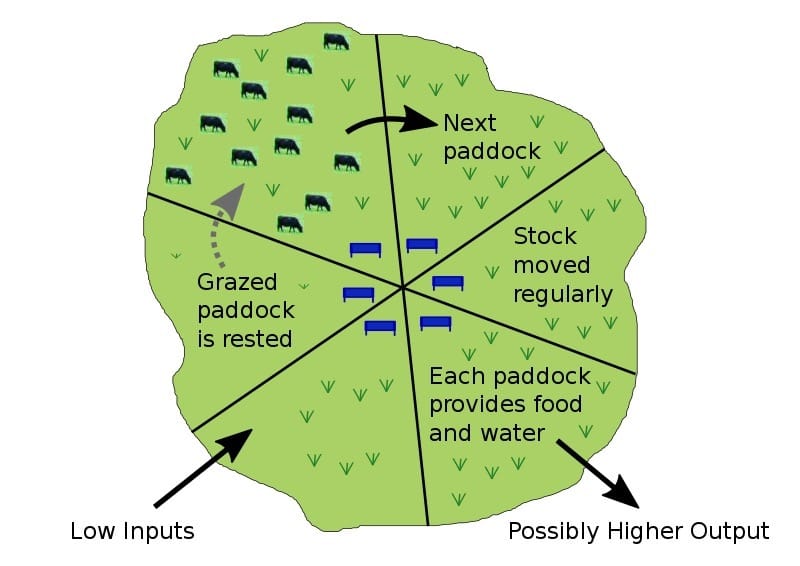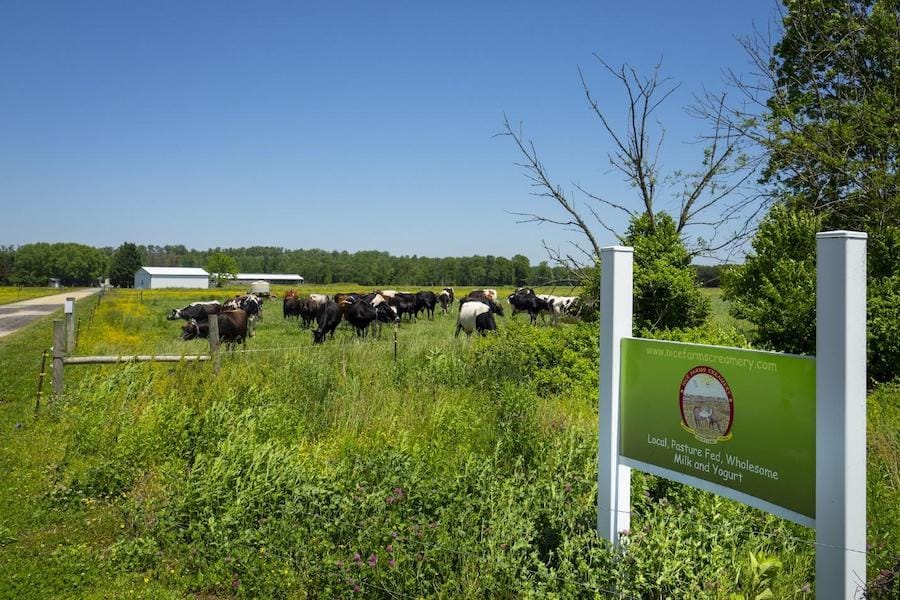It is often said that ‘necessity is the mother of invention’. Most times, if not always, life-changing creations and powerful concepts have emerged as solutions to serious issues.
And rotational grazing is no exception.
Today, we’re going to transport you back to school for a quick history lesson on rotation grazing and how it came to be.
But first, let’s brush up on what rotational grazing is.
Rotational grazing is the practice of moving animals through planned pieces of pasture.
Only one portion of pasture is grazed at any given time, while the rest of the pasture is allowed to rest. To do this, farmers divide pastures into smaller chunks of land, also known as paddocks, and the livestock is moved from one paddock to the next.
When you let animals loose to graze anywhere they’d like to, they could end up irreversibly damaging the pasture and in turn, lowering the quality of the soil.
On the other hand, when rotational grazing is practised, it’s great for soil health.
It nudges the plants to send out deep roots that in turn boost the biomass of the soil and increase fertility. This is almost like a hain reaction that helps in sequestering carbon from the atmosphere and preventing erosion and agricultural runoff.

So now that we’re crystal clear on what rotational grazing is, let’s back up a bit and tune in to that history lesson we were talking about earlier, shall we?
At the turn of the 20th century, there was severe rangeland degradation. Rotational grazing was, an inspired solution to this huge issue and what has developed a century ago, continues to be the grazing norm even today.
When farmers in the 20th century practised continuous grazing, it led to certain patches of land being severely grazed while other patches of land just remained there unproductively. All this caused root degradation, a fall in the diversity of plants, erosion and low animal performance leading to low returns and low income.
The natural response was to figure out another way in which cattle could be fed, without affecting the quality of the land and thus, rotational grazing was invented.
All about Arthur
The very first mention of the term rotational grazing can be traced back to the year 1950, when a certain Arthur Sampson organized a symposium on rotational grazing in North America, at the third annual meeting of the Society for Range Management. He is credited with many firsts, including rotational grazing.
Let’s explore the life of Arthur Sampson a little bit, shall we? After all, we have a lot to be thankful to him for!
Sampson was born on March 27, 1884, in Nebraska, Canada. He majored in botany and plant ecology at the University of Nebraska. After finishing his studies, Sampson joined the Forest Service and worked as a plant ecologist.
It was here that he started to develop a keen interest in overgrazing. He began extensively researching on this topic in the Blue Mountains of Oregon.
Samson’s keen eye and passion for research led to the publication of more than 200 science journals, just one year after he joined the Forest Service! Isn’t that amazing?
In the years surrounding 1912, floods, erosion through the year and regular mudflows kept damaging and ruining lands in the West for decades. It was then that Sampson decided to intensively study what overgrazing had to do with these continuous natural disasters.
With the help of his friends and fellow scientists, Sampson built enclosures in Ephraim Canyon. He also built drainages on the east side of the Wasatch Plateau.
He cordoned off the area using log fences so that no animals would be able to enter and then he deeply studied the effect on the soil and plants in that area when there was absolutely no grazing done there.
This little exercise actually gave birth to about 80 years of data that scientists continue to access today! Wasn’t that just light years ahead of his time?
Sampson mainly studied three areas in grazing:
- Using artificial and natural reseeding to produce the maximum forage possible
- How livestock can use forests without causing any damage to plant reproduction and watershed conditions
- How to achieve the maximum grazing efficiency per unit by using herding methods, water utilization and studying poisonous plants
After he researched these subjects, Sampson, or Sammy as he was affectionately called, left the Forest Service and taught at the University of California in Berkeley. It was here that he started his first range management course and he also wrote four textbooks.
Range management to put it simply is the management of grasslands so that cattle graze it in a way that maintains and increases both plant and animal production. Nebraska has been credited as the state where range management was officially born.
One of Sampson’s books titled Range and Pasture Management that was published in 1923 was so well received and also one of the first-ever in-depth books on this subject. This earned Sampson great laurels and he was subsequently christened the ‘father of range management’!
But we all have our own sources of inspiration – those people or ideas we interact with that give birth to greater ideas. And Arthur Sampson’s inspiration was Edwin Bessey.
Who was Edwin Bessey?
Edwin Bessey was a botanist who is credited with having changed the course of botany. He viewed botany not as just science that observes plants, but as applied science to be studied with microscopes and chemicals and what not!
Bessey networked with farmers and ranchers to come up with solutions to weed problems. He also studied plants and their relationship with natural elements like soil, drought, rain and the environment as a whole.
And now, it’s time for a major plot twist in this history lesson.
Arthur William Sampson was none other than Bessey’s *drumroll* student! Sampson studied botany and plant ecology under Bessey. Under Bessey’s tutelage, he too was inspired to study botany like an applied science instead of observational science and utilized tools to conduct his research.
James Anderson
Other research points to James Anderson, who had described the principle of rotational grazing towards the end of the 18th century in Scotland. However, the actual implementation of rotational grazing systems on grasslands happened a lot later.
Working as an agriculturist in Scotland in the late 1700s, James Anderson wrote all about daily rotation, allowing cattle on pasture when the grass is at the optimum stage of growth and then giving the plants time for recovery.
Back then, rotational grazing was done by building miles and miles of stone fences and since that was such a difficult task, most farmers didn’t do it.
In Ireland, a severe potato famine caused a lot of farms to be abandoned in the 1840s and 1850s. When these farms later showed up in pictures, they were sub-divided with stone fences. There were also ditches that were dug by hand, that started at the top of the farm and when through the pasture entirely.
From the days of stone fences and hand-dug ditches, grazing systems have evolved during the course of the 20th century. From simple deferred systems to sophisticated rotational systems and then, to intensive short-duration systems, rotational grazing steered by science and technology has definitely reaped a rainbow of benefits for our farms.

Today, rotational grazing is a sturdy science and you can use professional services to help you plan your rotational grazing well along with fence placements, to the sizing of paddocks, managing streams and wetlands and boosting overall farm operations.
All said and done, you also need to regularly measure your pasture growth.
Why? Because rotational grazing based on pasture growth measurements can help you earn more profits and improve pasture health.
If interested, do check out Pasture.io and learn how it can help you measure pasture growth accurately and automatically.
We hope you enjoyed this little history lesson. Keep an eye out on our website and blogs for a lot more information coming your way!
Until we meet again, Happy Farming!
- The Dedicated Team of Pasture.io, 2020-10-08